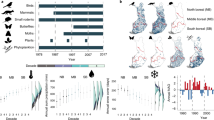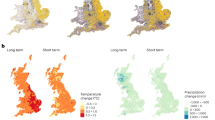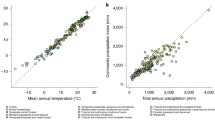Abstract
Over the past 100 years, the global average temperature has increased by approximately 0.6 °C and is projected to continue to rise at a rapid rate1. Although species have responded to climatic changes throughout their evolutionary history2, a primary concern for wild species and their ecosystems is this rapid rate of change3. We gathered information on species and global warming from 143 studies for our meta-analyses. These analyses reveal a consistent temperature-related shift, or ‘fingerprint’, in species ranging from molluscs to mammals and from grasses to trees. Indeed, more than 80% of the species that show changes are shifting in the direction expected on the basis of known physiological constraints of species. Consequently, the balance of evidence from these studies strongly suggests that a significant impact of global warming is already discernible in animal and plant populations. The synergism of rapid temperature rise and other stresses, in particular habitat destruction, could easily disrupt the connectedness among species and lead to a reformulation of species communities, reflecting differential changes in species, and to numerous extirpations and possibly extinctions.
This is a preview of subscription content, access via your institution
Access options
Subscribe to this journal
Receive 51 print issues and online access
$199.00 per year
only $3.90 per issue
Buy this article
- Purchase on SpringerLink
- Instant access to full article PDF
Prices may be subject to local taxes which are calculated during checkout


Similar content being viewed by others
References
Houghton, J. T. et al. (eds) in Climate Change 2001: The Science of Climate Change (Cambridge Univ. Press, New York, 2001)
Harris, A. H. Wisconsinan pre-pleniglacial biotic change in southeastern New Mexico. Quat. Res. 40, 127–133 (1993)
Schneider, S. H. & Root, T. L. in Status and Trends of the Nation's Biological Resources Part 1 (eds Mac, M. J., Opler, P. A., Puckett Haecker, N. & Doran, P. D.) 89–116 (US Geological Survey, Reston, Virginia, 1998)
Walther, G.-R. et al. Ecological responses to recent climate change. Nature 416, 389–395 (2002)
Penuelas, J. & Filella, I. Responses to a warming world. Science 294, 793–795 (2001)
McCarthy, J. J., Canziani, O. F., Leary, N. A., Dokken, D. J. & White, K. S. (eds) Climate Change 2001: Impacts, Adaptations, and Vulnerability (Cambridge Univ. Press, New York, 2001)
Root, T. L. & Schneider, S. H. in Wildlife Responses to Climate Change: North American Case Studies (eds Schneider, S. H. & Root, T. L.) 1–56 (Island Press, Washington DC, 2002)
Hunter, J. E. & Schmidt, F. L. Methods of Meta-Analysis: Correcting Errors and Bias in Research Findings (Sage, Thousand Oaks, California, 1995)
Raju, N. S., Fralicx, R. & Steinhaus, S. D. Covariance and regression slope models for studying validity generalization. Appl. Psychol. Meas. 10, 195–211 (1986)
Overpeck, J. T., Webb, R. S. & Webb, T. III Mapping eastern North American vegetation change over the past 18,000 years: no analogs and the future. Geology 20, 1071–1074 (1992)
Darwin, C. On the Origin of Species: A Facsimile of the First Edition (Harvard Univ. Press, Cambridge, Massachusetts, 1964)
Myers, N. in Biodiversity II: Understanding and Protecting our Biological Resources (eds Reaka-Kudla, M. L., Wilson, D. E. & Wilson, E. O.) 125–138 (Joseph Henry, Washington DC, 1997)
Fleming, R. A. & Tatchell, G. M. in Insects in a Changing Environment (eds Harrington, R. & Stork, N. E.) 505–508 (Academic, San Diego, California, 1995)
Hedges, L. V. & Olkin, I. Statistical Methods for Meta-Analysis (Academic, New York, 1985)
Acknowledgements
T.L.R. acknowledges partial support from the US Environmental Protection Agency, the Winslow Foundation, the University of Michigan's Office of the Vice President for Research, and the School of Natural Resources and Environment. S.H.S. acknowledges partial support from the Winslow Foundation. We thank T. Haff, J. Jeffries, M. Kirpes, J. Manternach, T. Reed, A. Stover, C. Wood and J. Cary for their efforts. In addition, we thank M. Apps, J. Magnuson and C. Parmesan for stimulating discussions and for help in finding obscure articles.
Author information
Authors and Affiliations
Corresponding author
Ethics declarations
Competing interests
The authors declare that they have no competing financial interests.
Supplementary information
Rights and permissions
About this article
Cite this article
Root, T., Price, J., Hall, K. et al. Fingerprints of global warming on wild animals and plants. Nature 421, 57–60 (2003). https://doi.org/10.1038/nature01333
Received:
Accepted:
Issue Date:
DOI: https://doi.org/10.1038/nature01333
This article is cited by
-
Thinner bats to face hibernation as response to climate warming
Scientific Reports (2024)
-
Relative contributions of taxonomic and functional diversity to the assembly of plant communities hosting endemic Dianthus species in a mountain steppe
Scientific Reports (2024)
-
Environmental dynamics of the western European Mediterranean landscape during the Pleistocene to Holocene transition
Vegetation History and Archaeobotany (2024)
-
Application of MaxEnt modeling to evaluate the climate change effects on the geographic distribution of Lippia javanica (Burm.f.) Spreng in Africa
Environmental Monitoring and Assessment (2024)
-
Study of orchids (Orchidaceae) distribution and richness for conservation implications in Tripura, North East India
Vegetos (2024)



